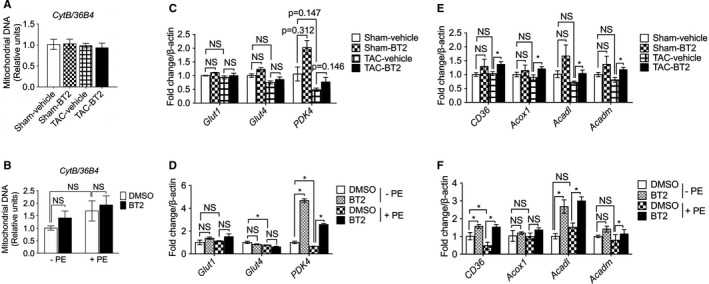Figure 5.

BT2 treatment altered the expression of genes involved in substrate metabolism. A, C, and E, Hearts were collected after 6 weeks of treatment with either vehicle or BT2 (8 weeks after surgery). B, D, and F, Neonatal rat ventricular myocytes (NRVMs) were treated with vehicle or phenylephrine (100 μmol/L) for 24 hours, followed by treatments of BT2 (80 μmol/L, dissolved in dimethyl sulfoxide [DMSO]) or 0.1% DMSO as control for an additional 24 hours. Mitochondrial DNA amounts in mouse hearts (A) and NRVMs (B) were analyzed by quantitative polymerase chain reaction (PCR) using primers specific for the mitochondrial cytochrome b (CytB) gene and normalized to genomic DNA by amplification of the large ribosomal protein p0 (36B4) nuclear gene. mRNA expression of genes involved in glucose transportation (Glut1 and Glut4) and oxidation (PDK4) in mouse hearts (C) and NRVMs (D) was determined by quantitative PCR. mRNA expression of genes involved in fatty acid transport (CD36) and β‐oxidation (Acox1, Acadl, and Acadm) in mouse hearts (E) and NRVMs (F) was analyzed by quantitative PCR. For animal studies: n=3 for sham‐vehicle group, n=3 for sham‐BT2 group, n=5 for transverse aortic constriction (TAC)–vehicle group, n=7 for TAC‐BT2 group. For NRVM experiment: n=3 for each group. Two‐way ANOVA, followed by Bonferroni's post hoc test, was performed for multiple comparison. Data were presented as mean±SD. NS indicates not significant. *P<0.05.
